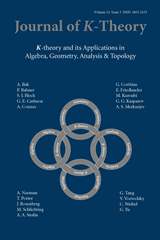No CrossRef data available.
Article contents
Clifford modules and invariants of quadratic forms
Published online by Cambridge University Press: 22 March 2011
Abstract
We construct new invariants of quadratic forms over commutative rings, using ideas from Topology. More precisely, we define a hermitian analog of the Bott class with target algebraic K-theory, based on the classification of Clifford modules. These invariants of quadratic forms go beyond the classical invariants defined via the Clifford algebra. An appendix by J.-P. Serre, of independent interest, describes the “square root” of the Bott class in the general framework of lambda rings.
- Type
- Research Article
- Information
- Copyright
- Copyright © ISOPP 2011




